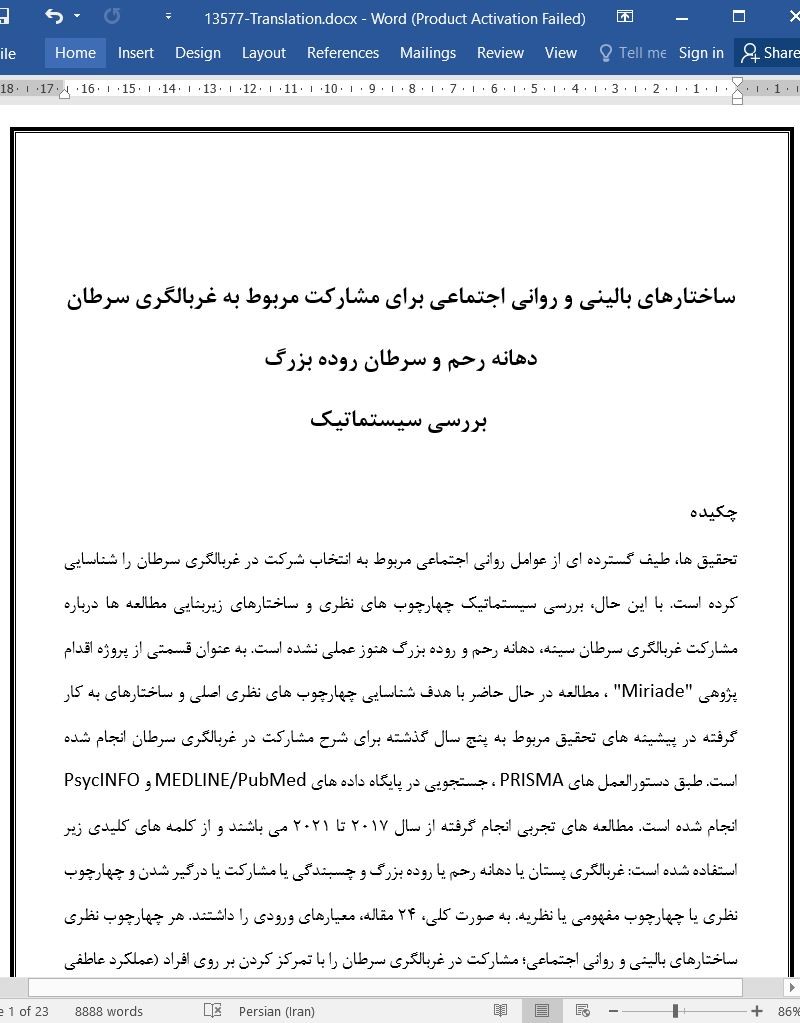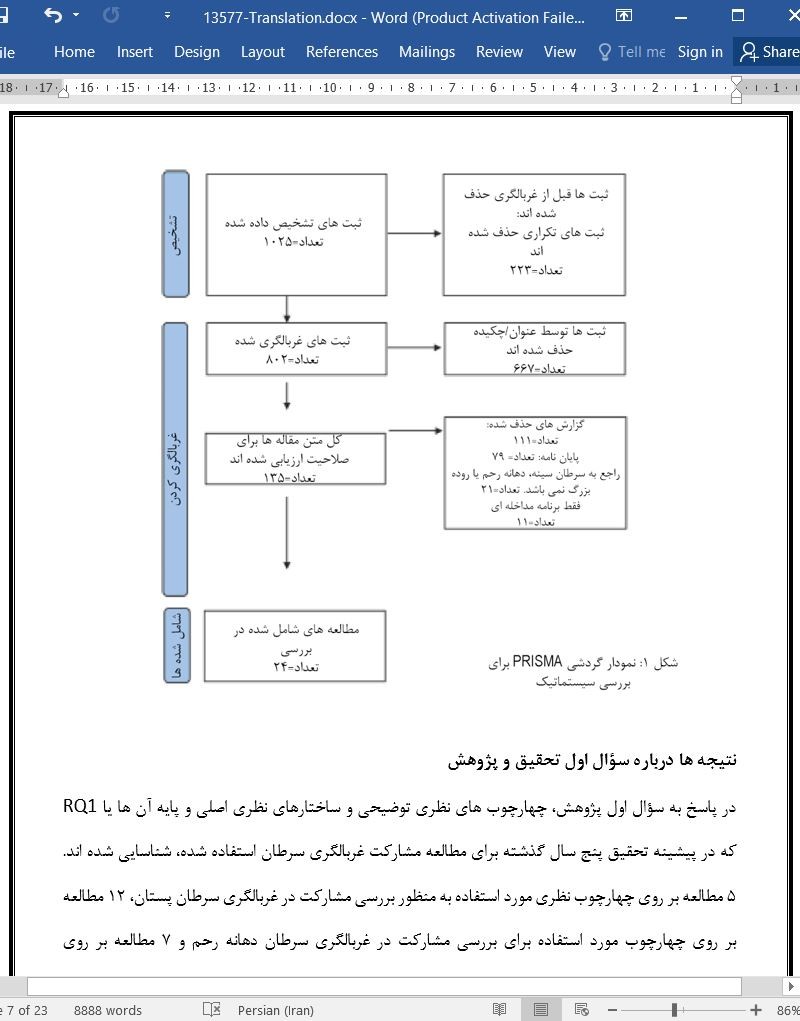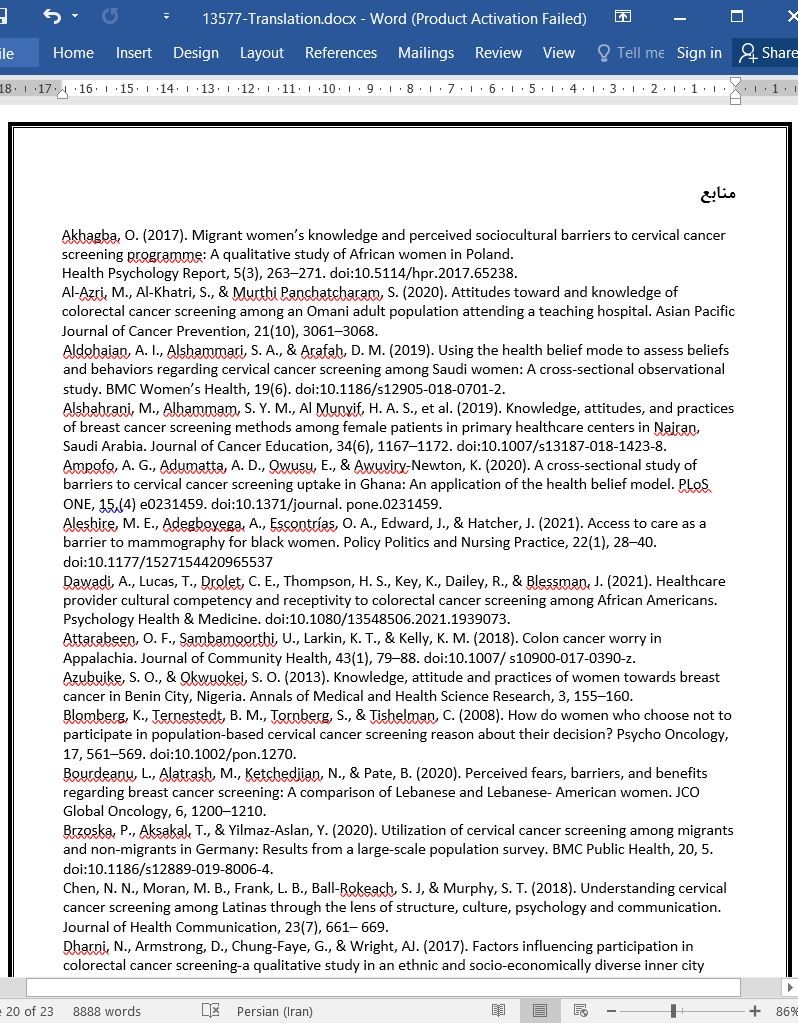
دانلود مقاله ساختارهای بالینی و روانی اجتماعی برای مشارکت مربوط به غربالگری سرطان دهانه رحم و سرطان روده بزرگ
چکیده
تحقیق ها، طیف گسترده ای از عوامل روانی اجتماعی مربوط به انتخاب شرکت در غربالگری سرطان را شناسایی کرده است. با این حال، بررسی سیستماتیک چهارچوب های نظری و ساختارهای زیربنایی مطالعه ها درباره مشارکت غربالگری سرطان سینه، دهانه رحم و روده بزرگ هنوز عملی نشده است. به عنوان قسمتی از پروژه اقدام پژوهی "Miriade" ، مطالعه در حال حاضر با هدف شناسایی چهارچوب های نظری اصلی و ساختارهای به کار گرفته در پیشینه های تحقیق مربوط به پنج سال گذشته برای شرح مشارکت در غربالگری سرطان انجام شده است. طبق دستورالعمل های PRISMA ، جستجویی در پایگاه داده های MEDLINE/PubMed و PsycINFO انجام شده است. مطالعه های تجربی انجام گرفته از سال 2017 تا 2021 می باشند و از کلمه های کلیدی زیر استفاده شده است: غربالگری پستان یا دهانه رحم یا روده بزرگ و چسبندگی یا مشارکت یا درگیر شدن و چهارچوب نظری یا چهارچوب مفهومی یا نظریه. به صورت کلی، 24 مقاله، معیارهای ورودی را داشتند. هر چهارچوب نظری ساختارهای بالینی و روانی اجتماعی؛ مشارکت در غربالگری سرطان را با تمرکز کردن بر روی افراد (عملکرد عاطفی روانی و طرح مهارت) و یا دیدگاه های مربوط به خدمات بهداشتی برجسته می کند. نتایج و یافته های این مطالعه، اکثریت نسبی چهارچوب های نظری و ساختارهای به دست آمده را برای پیش بینی کردن یا ارتقای چسبندگی غربالگری سرطان سینه، دهانه رحم و روده بزرگ تأیید و در نهایت، تلاش های تحقیقاتی جدیدی به منظور بهبود اثربخشی، مداخله های ترویج غربالگری سرطان را تأیید می کند.
مقدمه
سرطان یکی از علت های اصلی عوارض و مرگ و میر در کل دنیا می باشد (WHO, 2020). با این حال، می توانیم از بخش های قابل توجهی از تشخیص های سرطان جلوگیری کنیم و میزان بقا را با اجرای استراتژی های پیشگیری مثل غربالگری سرطان، توسعه بدهیم. غربالگری سرطان نیازمند تشخیص سرطان در مرحله رشد بدون هیچ گونه علائمی می باشد (Ogden et al., 2012; Rex et al., 2000) و آن هایی را شناسایی می کند که در میان افراد به ظاهر سالم مثل مداخله زودهنگام و مؤثرتر، در معرض خطربالاتری هستند.
پس سیستم های مراقبت های بهداشتی در کل جهان در تلاش هستند تا از عدالت در دسترسی به برنامه های به موقع، تخصصی و رایگان غربالگری سرطان مطمئن شوند. این امر با دعوت از جمعیت هدف برای شرکت کردن در برنامه های غربالگری مناسب که طبق توصیه های وزارت بهداشت برای جلوگیری از سرطان های سینه، دهانه رحم و روده بزرگ است، انجام می گیرد. برای خطر مبتلا شدن به سرطان سینه، زنان 50 تا 69 ساله، هر دو سال یک بار ماموگرافی دو طرفه را انجام می دهند. برای خطر ابتلا به سرطان دهانه رحم، زنان 25 تا 64 ساله هر سه سال یکبار تست پاپ یا ویروس پاپیلومای انسانی یا HPV را انجام و برای خطر ابتلا به سرطان روده بزرگ، افراد بین 50 تا 74 سال هر دو سال یکبار، بدون در نظر گرفتن تفاوت جنسیت، آزمایش خون مخفی مدفوع با حساسیت بالا یا FOBTs یا کولونوسکوپی را انجام می دهند (WHO, 2020).
نتیجه گیری
از نتایج به نظر می رسد روشن و واضح است که اجرای یک رویکرد فردگرایانه برای همراهی با انتخاب های پیشگیرانه مطلوب کافی نیست. همه گروه های دلایل، زمینه های فردی، رابطه ای و اجتماعی در فرآیند تصمیم گیری دخیل می باشند. برای توسعه مداخلات موفق برای بهتر شدن مشارکت در زمینه غربالگری سرطان، نیاز به استفاده از تئوری در طراحی مداخله ای با هدف ساختارهای شناختی و رفتاری، با هدف اثرات اجتماعی، جنبه های عاطفی موضوع و قابلیت دسترسی و پذیرش زمینه مشهود می باشد.
ما فکر می کنیم این حالت می تواند مفید باشد که توسعه یک قرائت تفسیری را در ذهن داشته باشیم. چون که آن ها را به عنوان محورهای عملکرد روانشناختی در نظر می گیرد و به روشی یکپارچه در درک پدیده مشارکت در غربالگری سرطان قرار می دهد.
Abstract
Research has identified a wide range of psychosocial factors associated to choosing to engage in ongoing cancer screenings. Nevertheless, a systematic review of the theoretical frameworks and constructs underpinning studies on breast, cervical, and colorectal cancer screening participation has yet to be conducted. As part of the action-research project “Miriade,” the present study aims to identifying the main theoretical frameworks and constructs adopted in the literature over the past five years to explain cancer screening participation. According to the PRISMA guidelines, a search of the MEDLINE/PubMed and PsycINFO databases was made. Empirical studies conducted from 2017 to 2021 were included. The following keywords were used: breast OR cervical OR colorectal screening AND adhesion OR participation OR engagement AND theoretical framework OR conceptual framework OR theory. Overall, 24 articles met the inclusion criteria. Each theoretical framework highlighted clinical and psychosocial constructs of cancer screening participation, focusing on the individuals (psycho-emotional functioning and skills plan) and/or the health services perspectives. Findings from the present study acknowledge the plurality of the theoretical frameworks and constructs adopted to predict or promote breast, cervical, and colorectal cancer screening adhesion and the need for new research efforts to improve the effectiveness of cancer screening promotion interventions.
Introduction
Cancer is one of the leading causes of morbidity and mortality worldwide (WHO, 2020). However, a substantial proportion of cancer diagnoses could be avoided and survival rates could be improved through the implementation of prevention strategies, such as cancer screenings. Cancer screenings entail detecting cancer at an asymptomatic stage of development (Ogden et al., 2012; Rex et al., 2000), identifing among apparently healthy people those who are at high risk, as well as to intervene early and more effectively.
Therefore, the healthcare systems worldwide are making efforts to ensure equity in access to timely, specialized, and free cancer screening programs. This is done by inviting the target populations to participate in tailored screenings programs that, according to the indications of the Ministry of Health, are for the prevention of breast, cervical and colorectal cancers. For the risk of breast cancer, women aged 50 to 69 are invited every two years for a bilateral mammogram; for the risk of cervical cancer, women aged between 25 and 64 are invited every three years to carry out Pap test or human papillomavirus [HPV] testing; for the risk of colorectal cancer, people from 50 to 74 years of age are invited every two years, without distinction of sex, to high-sensitivity fecal occult blood tests [FOBTs] or colonoscopy (WHO, 2020).
Conclusion
From the results, it appears clear that the implementation of an individualistic approach is not sufficient to bring along desired preventive choices. All groups of reasons, individual, relational and social context are involved in the decision-making process. To develop successful interventions to improve participation in the context of cancer screening, the need to use theory in the design of the intervention that aims at cognitive and behavioral constructs, aims at social influences, the emotional aspects of the subject and accessibility and acceptance of the context is evident.
We think it is useful to consider the development of an interpretative reading that considers them as psychological functioning axes to be considered in an integrated manner in understanding the phenomenon of participation in cancer screening.
چکیده
مقدمه
روش ها
استراتژی جستجو و جمع آوری داده ها
نتایج
انتخاب مطالعه
نتیجه ها درباره سؤال اول تحقیق و پژوهش
نتایج درباره سؤال دوم تحقیق و پژوهشی
بحث و نتیجه گیری
نتیجه گیری
منابع
Abstract
Introduction
Methods
Search strategy and data collection
Results
Study selection
Results about research questions one
Results about research question two
Discussion
Conclusion
References
این محصول شامل پاورپوینت ترجمه نیز می باشد که پس از خرید قابل دانلود می باشد. پاورپوینت این مقاله حاوی 17 اسلاید و 5 فصل است. در صورت نیاز به ارائه مقاله در کنفرانس یا سمینار می توان از این فایل پاورپوینت استفاده کرد.
در این محصول، به همراه ترجمه کامل متن، یک فایل ورد ترجمه خلاصه نیز ارائه شده است. متن فارسی این مقاله در 6 صفحه (1700 کلمه) خلاصه شده و در داخل بسته قرار گرفته است.
علاوه بر ترجمه مقاله، یک فایل ورد نیز به این محصول اضافه شده است که در آن متن به صورت یک پاراگراف انگلیسی و یک پاراگراف فارسی درج شده است که باعث می شود به راحتی قادر به تشخیص ترجمه هر بخش از مقاله و مطالعه آن باشید. این فایل برای یادگیری و مطالعه همزمان متن انگلیسی و فارسی بسیار مفید می باشد.
بخش مهم دیگری از این محصول لغت نامه یا اصطلاحات تخصصی می باشد که در آن تعداد 50 عبارت و اصطلاح تخصصی استفاده شده در این مقاله در یک فایل اکسل جمع آوری شده است. در این فایل اصطلاحات انگلیسی (تک کلمه ای یا چند کلمه ای) در یک ستون و ترجمه آنها در ستون دیگر درج شده است که در صورت نیاز می توان به راحتی از این عبارات استفاده کرد.
- ترجمه فارسی مقاله با فرمت ورد (word) با قابلیت ویرایش و pdf بدون آرم سایت ای ترجمه
- پاورپوینت فارسی با فرمت pptx
- خلاصه فارسی با فرمت ورد (word)
- متن پاراگراف به پاراگراف انگلیسی و فارسی با فرمت ورد (word)
- اصطلاحات تخصصی با فرمت اکسل



